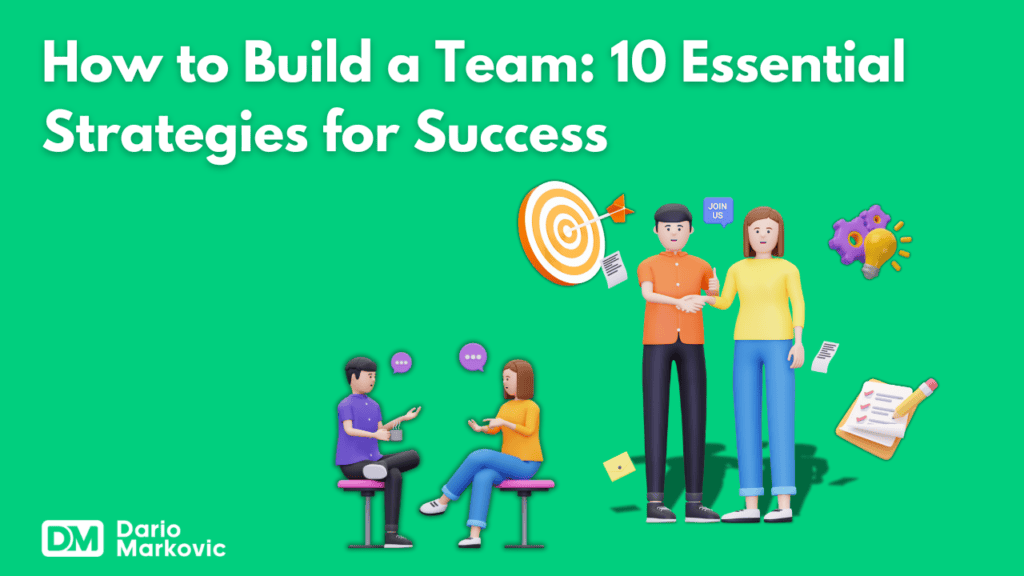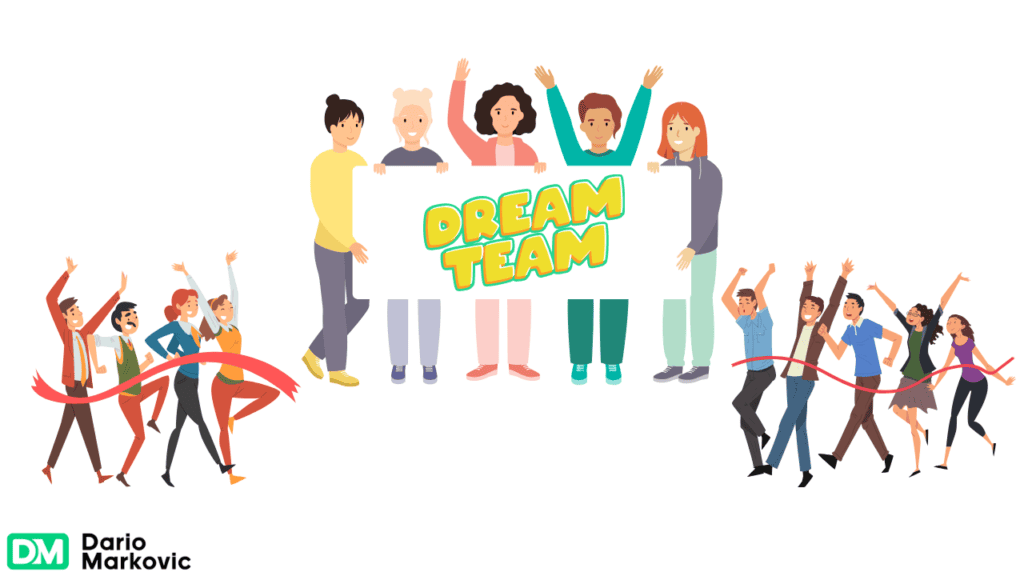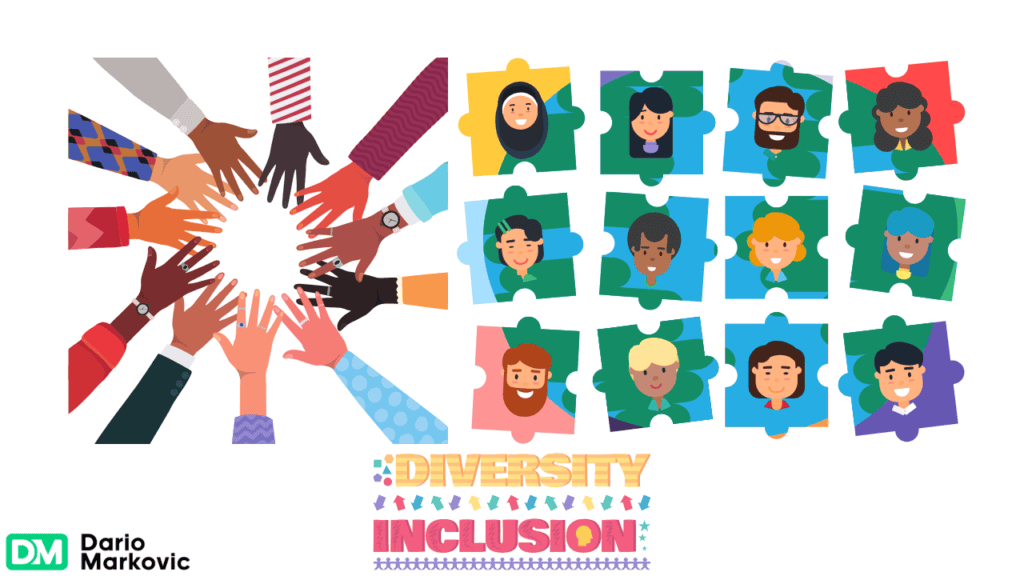Wondering how to build a team that performs?
Creating an effective team is key to your business’s success.
This article provides actionable tips on defining roles, setting goals, and fostering collaboration. Expect practical strategies to turn individual contributors into a cohesive, high-performing team.

What is Team Building?
Team building creates a cohesive, influential group working harmoniously towards common goals. It involves defining clear roles, fostering open communication, and encouraging collaboration among team members.
By establishing a solid foundation of trust, shared values, and mutual support, team building aims to enhance productivity, motivation, and overall team performance.
To achieve these objectives, here are 10 essential strategies for building a strong team:
1. The Importance of Building a Strong Team

In today’s competitive business landscape, fostering a cohesive and effective team is more crucial than ever. My teaching skills are essential in this context, as they empower leaders to build, nurture, and sustain teams that drive success and innovation.
By imparting strategies and techniques for enhancing teamwork, I help organizations create environments where collaboration and Engagement flourish, increasing productivity and employee satisfaction.
- Enhanced Collaboration: My teaching methods focus on improving communication and trust among team members, leading to seamless cooperation and reduced conflicts.
- With the Tools I provide, employee engagement is not just a concept but a reality. These tools ensure that every team member feels valued and is motivated to contribute their best efforts, leading to a more productive workforce.
Goal Achievement: Through structured guidance, teams learn to set and achieve collective goals efficiently, enhancing overall organizational performance. - My training is not just about building a team but also about creating a healthy work environment. Promoting a supportive team culture helps reduce burnout and fatigue, ensuring that employees can perform at their best.
Attracting Talent: Effective team dynamics attract top talent, as potential employees are drawn to organizations known for their positive and collaborative culture. - Retention of Employees: Strong team bonds and a supportive work environment increase employee retention, reducing turnover and associated costs.
My approach to team-building is the ideal solution for organizations aiming to enhance their operational efficiency and employee well-being. By leveraging proven techniques and fostering an inclusive, communicative atmosphere, my training ensures that teams meet their objectives and thrive in a supportive and engaging work environment.
This comprehensive method aligns with and drives the company’s vision and goals forward.
2. Defining Roles and Responsibilities

The need for clearly defined team roles and responsibilities has never been more critical. As a specialist in this area, my teaching skills are essential to guiding teams through the process of establishing clear and effective roles.
This ensures every member understands their duties, leading to enhanced productivity and team morale.
- Prevents Confusion and Stress: Clear roles eliminate ambiguity, reducing stress and confusion among team members.
- Enhances Accountability: Defined responsibilities foster a sense of accountability, motivating team members to perform their duties effectively.
- Improves Performance Measurement: Specific roles make tracking performance and providing constructive feedback easier.
- Aligns Efforts with Objectives: Clear goals allow team members to align their work with the team’s objectives, increasing overall performance by 25%.
- Boosts Efficiency and Effectiveness: Well-defined roles can boost efficiency by 53% and effectiveness by 27%, significantly enhancing team performance.
By utilizing my method, which emphasizes clarity, accountability, and alignment, teams can achieve cohesion and efficiency that is essential for success. My approach ensures that every team member knows their role and responsibilities, improving individual performance and fostering a more productive and harmonious team environment.
This method is ideal for any team looking to maximize their potential and achieve their goals.
3. Establishing a Positive Team Culture
A positive team culture is the glue that holds a successful team together. Establishing a strong team culture unites individuals under shared values and norms, influencing their interactions and organizational goals.
This foundation shows team members how to behave and approach their work, ensuring everyone stays on the right track.
- Enhances team cohesion and unity
- Fosters a sense of belonging and purpose
- Promotes higher levels of engagement and motivation
- Encourages trust and mutual respect among team members
- Leads to better communication and collaboration
- Reduces conflicts and misunderstandings
- Increases overall productivity and job satisfaction
My teaching skills are the ideal solution for establishing a positive team culture. Focusing on leadership development, communication strategies, and team-building exercises, my method equips leaders with the tools they need to cultivate a supportive and transparent environment.
By instilling core values such as integrity, respect, and collaboration, I help teams create a culture where every member feels valued and motivated to contribute to the team’s success.
4. Setting Clear Goals and Expectations
Teaching the skill of setting clear goals and expectations is crucial in fostering effective teamwork and achieving organizational success. Clear goals provide a team roadmap, ensuring everyone understands their roles and responsibilities. This clarity minimizes misunderstandings, enhances productivity, and aligns efforts towards shared objectives.
Setting clear expectations also promotes team accountability and commitment, fostering a collaborative environment where members support each other and strive for excellence.
Ultimately, mastering this skill equips teams with the tools to navigate challenges, stay motivated, and consistently deliver impactful results.
Reasons Why Setting Clear Goals and Expectations is Important:
- Alignment: Ensures everyone is working towards the same objectives.
- Efficiency: Minimizes confusion and delays by clarifying roles and tasks.
- Accountability: Encourages team members to take ownership of their work.
- Communication: Facilitates open and effective communication.
- Motivation: Keeps team members focused and motivated.
- Collaboration: Enhances teamwork and mutual support.
- Performance: Improves overall team performance and productivity.
Addressing the need to teach this skill, an ideal solution involves structured training sessions combining theoretical knowledge with practical exercises.
Participants can develop proficiency in setting clear goals and expectations by simulating real-world scenarios and providing constructive feedback.
Additionally, personalized coaching can tailor strategies to individual team dynamics, ensuring applicability and effectiveness in diverse organizational contexts.
Such an approach not only equips teams with essential skills but also cultivates a culture of clarity, accountability, and collaboration essential for sustained success.
5. Encouraging Open Communication

Teaching and encouraging open communication is crucial in today’s collaborative work environments. As a facilitator, I empower individuals and teams with the tools to cultivate transparent dialogue and mutual understanding.
Effective communication is essential for fostering trust, resolving conflicts, and aligning team objectives. With it, teams can achieve their goals and maintain a cohesive work culture.
Here are specific reasons why teaching open communication is essential and relevant:
- Enhances Psychological Safety: Enables employees to voice opinions without fear of judgment or reprisal.
- Promotes Inclusion: Reduces cultural gaps by encouraging the sharing and understanding of diverse perspectives.
- Boosts Creativity and Innovation: Creates an environment where everyone feels comfortable contributing ideas.
- Improves Team Effectiveness: Facilitates better problem-solving and decision-making through more transparent communication channels.
My method emphasizes creating a structured approach to communication that fosters trust and collaboration. By implementing active listening techniques, regular feedback loops, and inclusive meeting practices, teams can experience enhanced productivity and job satisfaction.
This approach strengthens team dynamics and supports long-term organizational success by reducing turnover and promoting a positive work culture where every voice matters.
6. Fostering Collaboration and Teamwork

Encouraging collaboration and teamwork is vital to create a communal working environment where everyone’s opinions are valued. Clearly communicating expectations for collaboration from the start can set it as a standard practice, helping team members understand the importance of working together towards common goals.
Organizing team-building activities can help build connections and mutual understanding among team members. These activities not only enhance teamwork but also encourage creativity and innovation.
Some examples of team-building activities include:
- Offsite events
- Brainstorming sessions
- Icebreaker games
- Trust-building exercises
- Problem-solving challenges
By engaging in these activities to encourage team members, they are more likely to share and build upon each other’s ideas, leading to a more collaborative and productive work environment.
Leaders play a crucial role in fostering collaboration by:
- Demonstrating collaborative behaviors
- Setting an example for their team
- Actively participating in team activities
- Encouraging open communication
Investing in collaboration tools further facilitates seamless knowledge sharing and resource allocation, crucial for both remote and hybrid work settings.
By imparting and practicing these skills, individuals and teams can cultivate a culture of collaboration that drives sustained success and growth in any organization.
7. Embracing Diversity and Inclusion

Incorporating diversity and inclusion in the workplace has several benefits, including:
- Paving the way for more creative and innovative solutions
- Amalgamating unique insights and approaches
- Diverse teams are better at problem-solving as they offer a broader range of viewpoints
- Reducing biases and enhancing decision-making
Implementing diversity, equity, and inclusion initiatives can have several benefits, including:
- Fostering a culture of empathy and understanding
- Enhancing team engagement and motivation
- Promoting a sense of belonging and engagement
- Leading to higher employee productivity and satisfaction.
Moreover, embracing diversity in hiring practices can attract exceptional talent from varied backgrounds, enriching the team with different perspectives and experiences.
Providing diversity and inclusion training helps employees understand the value of diversity and recognize unconscious biases, further promoting a positive team culture.
8. Providing Regular Feedback and Recognition
My teaching skills are essential in fostering a constructive learning environment where employees can thrive and develop their full potential.
Here’s why my teaching skill is crucial:
Facilitating Learning: Effective teaching ensures employees grasp concepts and apply them confidently.
Motivating Employers: By inspiring and encouraging learners, teaching ignites their curiosity and eagerness to explore new ideas.
Building Confidence: Through constructive feedback, employees gain the assurance to overcome challenges and achieve academic success.
Adapting to Individual Needs: Tailoring teaching methods to cater to diverse learning styles ensures that every employee can progress effectively.
Fostering Critical Thinking: Teaching cultivates analytical skills and encourages employees to question, evaluate, and innovate.
My approach seamlessly integrates these principles, providing a structured yet adaptive framework to support each employee’s journey toward academic excellence. By combining regular feedback and recognition with engaging instructional methods, I ensure that employees absorb knowledge and feel valued for their efforts.
This approach enhances academic performance and nurtures a positive and supportive classroom atmosphere where employees feel appreciated and motivated to excel.
9. Supporting Professional Development
As a CEO, my skills are crucial in fostering professional development within organizations. Through structured training programs, mentorship initiatives, and continuous learning opportunities, I enhance employee satisfaction and reduce turnover rates.
By promoting a culture of learning and growth, I help teams thrive and adapt to evolving challenges in their respective fields.
- Facilitates Skill Exchange: Teaching facilitates the exchange of skills and knowledge among employees through mentorship programs, aiding their professional and personal development.
- Promotes Continuous Improvement: Teaching fosters a culture of continuous improvement by not only providing structured learning activities but also encouraging independent learning. This approach empowers employees to seek new ideas and perspectives, promoting self-motivation and growth.
- Enhances Networking and Learning: Teaching also involves organizing industry events like workshops and seminars. These events provide a platform for employees to acquire new skills, expand their networks, and stay updated with industry trends, enhancing their professional development.
- Tailored Development Plans: Conducting personalized interviews enables the creation of tailored development plans, ensuring employees possess the necessary skills to excel in their roles.
My method provides an ideal solution by integrating various educational approaches tailored to meet the diverse needs of employees. Through structured mentorship, ongoing training sessions, and engaging events, I cultivate an environment where learning becomes a fundamental part of organizational culture, empowering individuals to achieve their full potential and drive collective success.
10. Celebrating Successes and Milestones
Acknowledging team victories and milestones is vital in enhancing morale and motivation. Regularly acknowledging and celebrating achievements contributes to a positive and supportive team environment, reinforcing the value of collaboration and teamwork.
Public recognition, such as sharing success stories, can raise a team member’s profile and morale, making them feel valued and appreciated. However, it’s essential to consider the preferences and personalities of team members when planning celebrations to ensure they are effective and well-received.
Acknowledging and celebrating achievements helps build a driven team that seeks to improve results, enhancing overall team performance and satisfaction. Celebrating successes creates a culture of recognition and appreciation, motivating team members to continue striving for excellence.
Key Considerations for How to Build a Team
Building a strong, cohesive team foundation with trust, open communication, and shared values is essential for business success and employee well-being.
Clear roles, responsibilities, and expectations enhance team efficiency, accountability, and performance by preventing confusion and aligning individual efforts with team goals.
Encouraging open communication, collaboration, and celebrating successes foster a positive team culture, driving motivation, innovation, and overall team engagement.
Dario's Summary
In summary, building a successful team requires a combination of clear roles, positive culture, open communication, and continuous development. Each of these strategies plays a vital role in fostering a cohesive and high-performing team. By implementing these essential strategies, you can create a thriving work environment where everyone feels valued and motivated to contribute their best.
Remember, a successful team is built on trust, collaboration, and shared goals. As you put these strategies into practice, you’ll see the positive impact on your team’s performance and overall company culture. So, take the first step today and start building the team of your dreams.
Frequently Asked Questions
Defining roles and responsibilities within a team is important because it prevents confusion, boosts productivity, and ensures efficient task completion.
Open communication benefits a team by enhancing trust, problem-solving, and collaboration, leading to a more comfortable and productive work environment. This creates a positive and efficient team dynamic.
Embracing diversity and inclusion in the workplace enhances creativity, fosters better decision-making, and improves employee engagement. It also helps attract a wider talent pool and strengthens the company’s reputation. Overall, a diverse team leads to more innovation, better problem-solving, and adaptability in global markets.
Regular feedback and recognition are important for a team because they help team members understand their progress, improve their performance, and feel valued and appreciated. They contribute to a positive and productive work environment.



